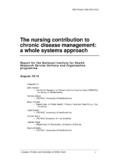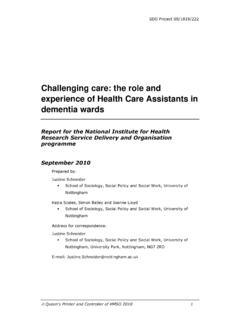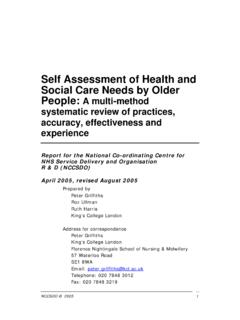Transcription of How to Spread Good Ideas - netscc.ac.uk
1 How to Spread good Ideas A systematic review of the literature on diffusion, dissemination and sustainability of innovations in health service delivery and organisation Report for the National Co-ordinating Centre for NHS Service Delivery and organisation R & D (NCCSDO) April 2004 prepared by Trisha Greenhalgh, Glenn Robert, Paul Bate University College London Olympia Kyriakidou, Fraser Macfarlane University of Surrey Richard Peacock University College London Address for correspondence Professor Trisha Greenhalgh Room 317 Holborn Union Building Highgate Hill London N19 5LW E-mail: Telephone: 00 44 20 7288 3246 Fax.
2 00 44 20 7281 8004 How to Spread good Ideas NCCSDO 2004 2 Contents Acknowledgements 5 Executive Summary Introduction and methods 6 Outline of research traditions 9 Results 12 Developing and testing a unifying conceptual model 26 Applying the model in a service context 28 Recommendations for further research 29 The Report Chapter 1 Introduction 32 Background and policy context 32 Scope of this research 37 Definitions 38 Classical diffusion of innovations theory an outline 45 Structure of this report 50 Chapter 2 Method 52 Outline of method 52 Planning phase 55 Search phase 56 Mapping phase 60 Appraisal phase 62 Synthesis phase 64 Justification of method 67 Chapter 3 Research traditions 70 Diffusion research the early roots 71 Rural sociology 74 Medical sociology 77 Communication studies 80 Marketing and economics 82 Limitations of early diffusion research 84 Development studies 87 Health promotion 90 Evidence-based medicine and guideline implementation 94 Organisational studie 97 Knowledge-based approaches to diffusion in
3 organisation 103 Narrative organisational studies 112 How to Spread good Ideas NCCSDO 2004 3 Complexity and general systems theory 115 Conclusion 118 Chapter 4 Innovations 121 Background literature on attributes of innovation 121 The Tornatsky and Klein meta-analysis of innovation attributes 126 Empirical studies of innovation attributes 130 Limitations of conventional attribution constructs for studying adoption in organisational settings 135 Attributes of innovations in the organisational context 140 Chapter 5 Adopters and adoption 143 Characteristics of adopters: background literature 143 Adoption as a process: background literature 149 Adoption of innovations in organisations: background and empirical studies 153 Chapter 6 Communication and influence 165 Communication and influence through interpersonal networks 165 Opinion leaders 170 Champions and advocates 182 Boundary spanners and change agents 188 The process of Spread 192 Chapter 7 The inner context 195 The inner context.
4 Background literature 195 Organisational determinants of innovativeness: meta-analyses 197 Organisational determinants of innovativeness: overview of primary studies in the service sector 204 Empirical studies on organisational size 206 Empirical studies on structural complexity 213 Empirical studies on leadership and locus of decision making 215 Empirical studies on organisational climate and receptive context 219 Empirical studies on supporting knowledge utilisation and manipulation 224 Chapter 8 The outer context 229 Inter-organisational influence through informal social networks 229 Inter-organisational influence through intentional Spread strategies238
5 Empirical studies of impact of environmental impact on organisational innovativeness 249 Empirical studies of impact of politics and policymaking on organisational innovativeness 252 How to Spread good Ideas NCCSDO 2004 4 Chapter 9 Implementation and sustainability 257 Overview 258 Measuring implementation, sustainability and related concepts 261 Implementation and sustainability: systematic reviews and other high-quality overviews 265 Empirical studies of interventions aimed at strengthening predisposition and capacity of the user system 275 Empirical studies of interventions aimed at strengthening the resource system and change agency 281 Empirical studies of linkage activities to support implementation 283 Empirical studies that have investigated whole-systems approaches to implementation 289 Chapter 10 Case studies 294 Developing and applying a unifying conceptual model 294 Case study 1.
6 Integrated care pathways ( the steady success story 298 Case study 2: GP fundholding ( the clash ) 301 Case study 3: Telemedicine ( the maverick initiative ) 304 Case study 4: The electronic health record ( the big roll-out ) 308 Conclusion 319 Chapter 11 Discussion 320 Overview and commentary on main findings 320 A framework for applying the model in a service contex 323 Stage 2 Considering the interaction between components 329 References 340 Glossary 372 Appendices Appendix 1 Data extraction form 374 Appendix 2 Critical appraisal checklists 377 Appendix 3 Descriptive statistics on included studies 388 Appendix 4 Tables of included studies 398 How to Spread good Ideas NCCSDO 2004 5 Acknowledgements This work would not have been possible without the support of)
7 The NHS SDO Programme and the input of the following colleagues, friends and peer reviewers: Stuart Anderson Diane Ketley Amanda Band Jos Kleijnen Huw Davies Francis Maietta Mary Dixon-Woods Andrew Moore Anna Donald Sandy Oliver Mike Dunning John vretveit Martyn Eccles David Patterson Gene Feder Ray Pawson Lindsay Forbes Paul Plsek Sarah Fraser Jennie Popay Jeremy Grimshaw Marcia Rigby Chris Henshall Helen Roberts Mike Kelly Stephanie Taylor. How to Spread good Ideas NCCSDO 2004 6 Executive Summary Introduction and methods Background This report describes a systematic review of the literature on the Spread and sustainability of innovations in health service delivery and organisation .
8 It was commissioned by the Department of Health via the NHS Service Delivery and organisation programme and undertaken between October 2002 and July 2003. The brief for the project was to inform the modernisation agenda set out in The NHS Plan and other policy documents and led by the NHS Modernisation Agency. Scope The review covers a very wide range of literature. It has focused primarily but not exclusively on research studies in the service sector, and the health care sector in particular. In areas where this literature was sparse, or where a wider literature provided important theoretical, methodological, or empirical information, we broadened the scope of the review accordingly.
9 Given the breadth of the research question and our own time limitations, we did not attempt an encyclopaedic coverage of all possibly relevant literature, and we have indicated areas where we believe additional work should be commissioned or undertaken. Definitions We defined a systematic review as a review of the literature undertaken according to an explicit, rigorous and reproducible methodology. We defined innovation in service delivery and organisation as a novel set of behaviours, routines and ways of working, which are directed at improving health outcomes, administrative efficiency, cost-effectiveness, or the user experience, and which are implemented by means of planned and co-ordinated action.
10 We distinguished between diffusion (a passive phenomenon of social influence), dissemination (active and planned efforts to persuade target groups to adopt an innovation) and implementation (active and planned efforts to mainstream an innovation). We noted an ambiguity in the notion of sustainability (the more an innovation is sustained or routinised in an organisation , the less the organisation will be open to new innovations). These definitions and inherent tensions are discussed in Section How to Spread good Ideas NCCSDO 2004 7 Search strategy We used a broad search strategy (described in detail in Section ), covering 11 separate electronic databases as well as hand searching 30 journals in the health care, health services research, organisation and management, and sociological literature.
















